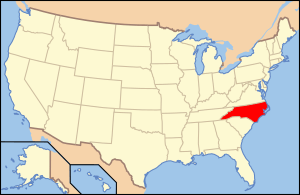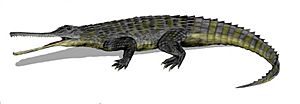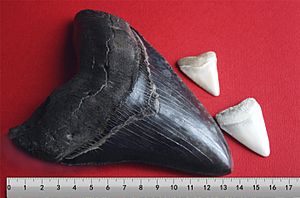Paleontology in North Carolina facts for kids
Paleontology in North Carolina is all about finding and studying fossils in the state of North Carolina. Fossils are very common here! Many major rivers and creeks east of Interstate 95 have places where you can find them. North Carolina's fossil record goes way back, from ancient remains 600 million years old to more recent ones from 10,000 years ago.
About 600 million years ago, North Carolina was covered by a warm, shallow sea. This sea was home to creatures like corals, jellyfish, and Pteridinium. This sea stayed for a long time during the early Paleozoic era. Many different sea animals lived there, leaving behind trace fossils like Skolithos. Later parts of the Paleozoic era don't have many rocks left, so we don't find many fossils from then.
By the Triassic period, North Carolina was dry land. Lakes and rivers had invertebrates (animals without backbones) and fish. On land, conifers and cycads (types of plants) grew. Dinosaurs and other ancient reptiles also lived here. The Jurassic period is mostly missing from North Carolina's rock record. But during the Cretaceous period, a shallow sea covered the state again. Creatures like belemnites lived in this sea. Sometimes, dinosaur bodies washed out to sea and were preserved.
After the Cretaceous, sea levels changed a lot. Marine invertebrates, bony fish, sharks, and whales were sometimes preserved as fossils. Cenozoic limestone is common in North Carolina and has many fossils. Gravel and marl pits are also great places to find fossils. Later Cenozoic marine life included the huge shark megalodon. During the later Pleistocene epoch, the sea left the state. Then, mammoths and mastodons roamed the land.
Some important early fossil finds happened in the 1850s. State geologist Ebenezar Emmons found Cretaceous reptile fossils. During the American Civil War, Confederate coal miners found many Triassic fossils. Around 1869, the state's first known dinosaur fossils were discovered.
Contents
- Prehistory of North Carolina's Fossils
- History of Fossil Discoveries
- Natural History Museums
- Notable Clubs and Associations
Prehistory of North Carolina's Fossils
The fossil record of North Carolina shows life from 600 million years ago (the Eocambrian period) up to 10,000 years ago (the Pleistocene period).
Ancient Life in the Eocambrian Sea
During the Eocambrian, North Carolina was covered by a sea. Over 600 million years ago, corals and jellyfish left their remains in Stanly County. These are the oldest known life forms in the state. They are also some of the oldest large fossils found anywhere in the world. Stromatolites, which are layered rock structures made by tiny living things, are quite common here. A few Ediacaran biota (early, soft-bodied creatures) have also been found. Two Pteridinium fossils were found in a creek in Stanly County. You can see one of them at the NC Museum of Natural Sciences. The disk-shaped Aspidella and the unusual Sekwia are also known from this time.
Cambrian Sea Creatures
North Carolina stayed covered by a shallow sea during the early Paleozoic era. The rest of the Paleozoic was a time of big changes in the land. There are no sedimentary rocks from this time that could have preserved fossils.
North Carolina has very few Cambrian fossils. The only known fossils from this period are tube-shaped trace fossils called Skolithos. However, some trilobites (ancient sea creatures) have been found in South Carolina from the same time. So, it's likely that trilobites also lived in North Carolina.
Triassic Dinosaurs and Plants
During the Triassic period, powerful forces created cracks in the land in North Carolina. Clams, crustaceans, and fish lived in the local lakes and rivers. On land, the plants included conifers and cycads. The early Mesozoic plants in North Carolina were very similar to those in nearby Virginia. North Carolina's Mesozoic plants left many fossils of cycads and conifers. At least nine types of Mesozoic plants are found only in North Carolina.
Around 210 million years ago, sediments of the Pekin Formation were laid down. Ferns and horsetails that grew in what is now Chatham County have left beautifully preserved fossils. Otozamites also grew there. Other fossils from the Triassic Pekin deposits include amphibians, fish scales, and petrified wood. This formation also preserves several kinds of Late Triassic reptiles. These include Pekinosaurus olseni, early relatives of modern crocodiles like the phytosaur Rutiodon, and several types of aetosaurs.
An interesting Triassic find was Uatchitodon. This was an archosauromorph reptile with hollow teeth that might have delivered venom. Fossil footprints called Apatopus and Brachychirotherium have been found here. These were likely made by archosaurs.
The Solite Quarry, which is on the border of Virginia and North Carolina, is another source of Late Triassic fossils. It preserved animals like crocodilians, phytosaurs, and lizard-like creatures. These left behind small bone pieces, teeth, and footprints. Dinosaur footprints were also made here during the Triassic. The Solite Quarry is most famous for its insect fossils. It's the only place on Earth where complete, well-preserved Triassic insects have been found. Many living insect groups have their oldest known examples preserved here. Insects from the Solite Quarry include staphylinid beetles, caddis-flies, belostomatids, and thrips.
Missing Jurassic Fossils
There are no known Jurassic rocks on the surface in North Carolina. However, there might be a large area of Late Jurassic rock deep underground near Cape Hatteras. It's very deep, so it's hard to get fossils from there. So far, only tiny ostracods (small crustaceans) have been found from deep drill cores.
Cretaceous Sea and Dinosaurs
During parts of the Cretaceous period, North Carolina was again covered by seawater. Local oysters left behind fossils. Areas not covered by the sea were home to dinosaurs. Around 75 million years ago, the Black Creek Formation (also called Donoho Creek Formation) was forming in southern North Carolina. This area was likely a river mouth environment. Dinosaurs were definitely part of the animals living here. This formation is the main place to find dinosaur fossils in the state.
Dinosaurs found here include the ornithomimid Coelosaurus antiquus, hadrosaurids like Hypsibema crassicauda and possibly Hadrosaurus. Also found were an unknown tyrannosauroid (maybe Dryptosaurus) and an unidentified leptoceratopsid. This leptoceratopsid was the first ceratopsian (horned dinosaur) found on the East Coast.
Cretaceous plants have also been preserved as fossils. Some ancient trees became petrified wood. One petrified log from this period in a small Cumberland County creek weighs thousands of pounds. It's still partly hidden by rock, but several feet of the two-foot-wide log stick out across the creek. Mollusks were very common in Cretaceous North Carolina. Their fossils are found in many places across the state. The Late Cretaceous Peedee beds are known for their belemnites and other mollusks.
Paleogene Marine Life
Sea levels also went up and down during the Paleogene period of the Cenozoic era. Sea creatures living then sometimes turned into fossils in the state.
Paleocene Fossils
During the Paleocene epoch, the seas pulled back. Because of this, very few fossils are known from this time. North Carolina has two Paleocene formations: the Beaufort Formation and the Bald Head Shoals Formation. The Beaufort Formation can be seen in some coastal areas. Brachiopods and bivalves (two-shelled mollusks) are common here. The large shark Palaeocarcharodon orientalis is also known from very rare teeth found in the Beaufort Formation.
The Bald Head Shoals Formation is found only near the mouth of the Cape Fear River. Its only visible parts are on islands made from river dredging. Mollusks and foraminifera (tiny single-celled organisms) are found here. A new species of turriteline gastropod (a type of snail) was found here in 2008.
Eocene Sharks and Whales
During the Eocene epoch, about 38 to 54 million years ago, North Carolina was home to marine life. Some of their remains are preserved in marl pits in Pender County. Among the invertebrates were nautiloids, sand dollars, and sea urchins. Vertebrates included bony fish, sharks, and whales. These fossil sites are quite famous. Sharks found here include early Tiger and Mako sharks.
Even though they are famous, North Carolina's Eocene fossils are often not very well preserved. Other invertebrates from this time included at least two types of gastropods, eleven pelecypods, two brachiopods, four echinoderms, and many different bryozoans (tiny colonial animals). You can find these fossils in Pitt, Craven, Lenoir, Wayne, Jones, Onslow, Duplin, and New Hanover counties.
Neogene Marine Giants
One Neogene marl pit near Aurora in Beaufort County is the most famous fossil site in the state. This single site preserves many Neogene fossils. These include coral, sand dollars, sea shells, sea urchins, fish remains, seals, sharks with huge teeth, and whale fossils.
Miocene Marine Life
During the later Miocene epoch, Craven County was home to at least 21 different types of pelecypods and 20 types of gastropods. The Yorktown Formation shows evidence of another group of animals. These included 43 different kinds of pelecypods, three scaphopods (tusk shells), and one crustacean. You can find these fossils in Halifax, Hertford, Martin, Beaufort, Bertie, Edgecombe, Pitt, and Craven counties. Fossil vertebrates from this time included whales and sharks. Other Miocene deposits show animals including 35 types of gastropods and 47 pelecypods in southern North Carolina and even into South Carolina. Shark tooth fossils also show that sharks were in the area.
Pliocene Megalodon and Horses
During the Pliocene epoch, North Carolina had many invertebrates. These included at least 25 types of gastropods and 46 types of pelecypods. Scallop fossils from the Pliocene are found in the Yorktown Formation in Northampton and Hertford counties. In Columbus and Onslow counties, Pliocene fossils are only found south of the Neuse River. Vertebrates included horses like Equus complicatus. A middle ear bone found in Pliocene deposits in Halifax County shows that whales lived there. Near the end of the Pliocene, North Carolina was home to animals like buffalo, megalodon, and whales. Their fossils were preserved in Halifax County.
Quaternary Ice Age Animals
Pleistocene Mammoths and Mastodons
During the Quaternary period, sea levels changed again. This happened as glaciers to the north grew or melted. Marine life was common in North Carolina during the Early Pleistocene. Later in this same epoch, a variety of animals left behind remains. These included a crustacean, 33 types of pelecypods, and 24 types of gastropods. Their fossils are found in Perquimans, Camden, Hyde, Pamlico, Craven, Carteret, Onslow, New Hanover, and Brunswick counties.
Pleistocene vertebrate life in North Carolina included the modern horse genus Equus. Their fossils are found in Halifax, Pitt, Washington, Pamlico, and New Hanover counties. Other kinds of horses left remains in Jones County. Whale fossils have been found in Halifax, Carteret, Craven, and Pamlico counties. Mammoth bones have been found in Carteret, Pamlico, and New Hanover Counties. Mastodon fossils are found in Carteret, Edgecombe, Nash, Craven, Jones, Pamlico, Onslow, Duplin, Wayne, Pender, New Hanover, and Brunswick Counties.
Pleistocene mastodon ivory was also found in Roanoke Rapids. Tapirs lived in Craven County. Manatees were found in Jones County. Megalodon teeth were found in Pamlico County. The walrus Odobenus rosmarus was preserved in Dare County.
History of Fossil Discoveries
Ebenezer Emmons became the state geologist in 1851. Before his time ended in 1863, he found fossils of Late Cretaceous reptiles. Later, during the American Civil War, Confederate miners were digging for coal. They found many fossils from the 210-million-year-old Late Triassic Pekin Formation. Around 1869, North Carolina's first known dinosaur fossils were discovered. Washington Caruthers Kerr found them in a Sampson County marl pit owned by James King. Later that same year, Edward Drinker Cope described these dinosaur remains as Hypsibema crassicauda.
Natural History Museums
- Aurora Fossil Museum, Aurora
- Cape Fear Museum, Wilmington
- Colburn Earth Science Museum, Asheville
- McKinney Geology Teaching Museum, Boone
- Museum of North Carolina Minerals, Spruce Pine
- North Carolina Museum of Life and Science, Durham
- North Carolina Museum of Natural Sciences, Raleigh
- Onslow County Museum, Richlands
- Rankin Museum of American Heritage, Ellerbe
- Schiele Museum of Natural History, Gastonia
Notable Clubs and Associations
- North Carolina Fossil Club, Inc.




